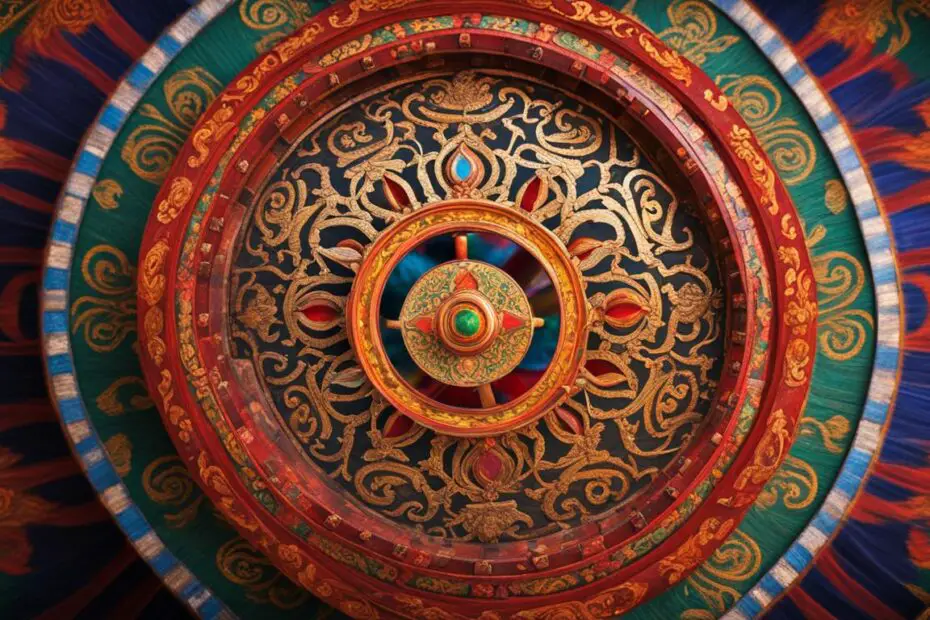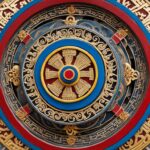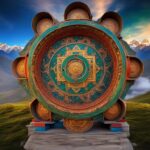Prayer wheels are cylindrical wheels made from various materials, including metal, wood, stone, leather, or cotton. They are widely used in Tibet and other areas where Tibetan culture is predominant. The wheels are inscribed with mantras, such as the commonly used “Om mani padme hum,” and often depict dakinis, Protectors, and the eight auspicious symbols. Spinning a prayer wheel is believed to have the same meritorious effect as reciting the prayers orally.
Key Takeaways:
- Prayer wheels are cylindrical wheels made from various materials and are widely used in Tibetan Buddhist culture.
- They are inscribed with mantras and symbolize the wheel of Dharma, the teachings of the Buddha.
- Spinning a prayer wheel is believed to accumulate merit, purify negative karma, and develop compassion and wisdom.
- There are variations in the design, construction, and rituals associated with prayer wheels among different Buddhist sects.
- Prayer wheels can be made from metal, wood, stone, leather, or cotton, with modern advancements incorporating lighter materials and innovative designs.
The Origins and History of Prayer Wheels
Prayer wheels have a rich history that dates back to the fourth century in Tibet and China. These cylindrical wheels have evolved from the revolving bookcases used in Buddhist monasteries. The Tibetan tradition suggests that prayer wheels originated from Indian masters Nagarjuna, Tilopa, Naropa, and Tibetan masters Marpa and Milarepa. Ancient texts mention the use of prayer wheels as a means to facilitate the chanting of sutras for illiterate individuals. It is believed that the rotation of the wheels is associated with yogic and Tantric practices.
Throughout their history, prayer wheels have held significant religious and spiritual meaning. They have been used as tools for meditation, devotion, and the accumulation of merit. The practice of spinning a prayer wheel is believed to have the same meritorious effect as reciting the prayers orally. Prayer wheels have played a crucial role in preserving the Buddhist teachings and spreading them to illiterate individuals.
In summary, the history of prayer wheels spans centuries, originating from revolving bookcases and finding its place in Tibetan Buddhist culture. These wheels hold deep spiritual significance and have been used as a means to facilitate devotion, meditation, and the accumulation of merit.
The Symbolism of Prayer Wheels
Prayer wheels hold deep symbolism in Tibetan Buddhist culture, representing the wheel of Dharma and serving as a physical embodiment of the Buddha’s teachings. The wheel itself is a powerful symbol, with the rim signifying the cycle of birth, death, and rebirth, and the hub representing liberation from this cycle. The spokes represent the different paths to enlightenment, particularly the noble eightfold path. The mantra inscribed on the wheel, typically “Om mani padme hum,” is associated with the Buddha of compassion, Avalokitesvara, and is believed to contain the essence of the Buddha’s teachings.
Turning the prayer wheel is not only a physical act but also a spiritual practice that engages all three aspects of body, speech, and mind. Through the mindfulness and meditation involved in spinning the wheel, practitioners develop compassion and wisdom, accumulating merit and purifying negativities. The spinning of the prayer wheel is seen as a metaphor for the turning of the wheel of the Dharma, symbolizing the continuous flow of the Buddha’s teachings and the journey towards enlightenment.
“The rim of the prayer wheel represents the cycle of birth, death, and rebirth, while the hub symbolizes liberation from this cycle. The spinning of the wheel is a metaphor for the turning of the wheel of the Dharma, representing the continuous flow of the Buddha’s teachings.”
Table: Symbolism of Prayer Wheels
| Symbol | Meaning |
|---|---|
| Wheel | Representation of the wheel of Dharma and the Buddha’s teachings |
| Rim | Symbolizes the cycle of birth, death, and rebirth |
| Hub | Signifies liberation from the cycle of birth and rebirth |
| Spokes | Represent the various paths to enlightenment |
| Mantra | Contains the essence of the Buddha’s teachings and associated with compassion |
While the symbolism of prayer wheels remains consistent across different sects of Buddhism, there may be variations in their specific practices and rituals. Advanced Tantric practitioners, for example, may spin the prayer wheel counterclockwise to manifest a wrathful protective energy. Different sects may also have their own preferred mantras or variations in the design and construction of the prayer wheels. Despite these variations, the overall purpose of accumulating wisdom, merit, and purifying negativities remains consistent, reflecting the core tenets of the Buddhist faith.
Variations Among Sects in Prayer Wheel Use
Prayer wheels hold significant importance for Buddhists across different sects, serving as tools for spiritual practice and meditation. While the fundamental purpose of prayer wheels remains consistent, there are variations in their specific practices and rituals among different Buddhist sects.
One notable difference lies in the direction of spinning the prayer wheel. While most sects spin the wheel clockwise, following the direction of the sun’s movement, advanced Tantric practitioners may spin it counterclockwise. This counterclockwise rotation is believed to manifest a wrathful protective energy.
Furthermore, different sects may have their own preferred mantras inscribed on the prayer wheels. While the mantra “Om mani padme hum” is commonly used, other sects may incorporate different mantras based on their respective traditions and lineage.
Cross-Comparison of Prayer Wheel Practices Among Buddhist Sects
| Buddhist Sect | Direction of Spinning | Preferred Mantra |
|---|---|---|
| Theravada | Clockwise | None specific, various mantras |
| Tibetan Buddhism | Clockwise | “Om mani padme hum” |
| Vajrayana | Counterclockwise | Mantras specific to the practitioner |
In addition to variations in the direction and mantras, different sects may also have variations in the design and construction of the prayer wheels. These variations can include differences in size, materials used, and artistic embellishments. These unique characteristics reflect the diverse cultural and spiritual expressions within each sect’s tradition.
Despite these variations, the underlying purpose of prayer wheel practice among Buddhist sects remains the same – to accumulate wisdom, merit, and purify negativities through the recitation of mantras and the mindful act of spinning the wheel.
Materials Used for Prayer Wheels
Prayer wheels are constructed from a wide range of materials, each with its own significance and aesthetic appeal. Traditional prayer wheels were commonly made from durable and ornate materials such as metal and wood. These materials not only symbolized strength and longevity but also conveyed a sense of reverence and devotion. Today, prayer wheels are crafted using various materials to accommodate different preferences and contexts.
Wooden prayer wheels offer a sense of warmth and natural beauty. They are often carved with intricate designs and embellishments, reflecting the craftsmanship and artistic traditions of the region. Metal prayer wheels, on the other hand, exude a sense of sacredness and grandeur. They are often adorned with carvings or engravings of religious symbols and mantras.
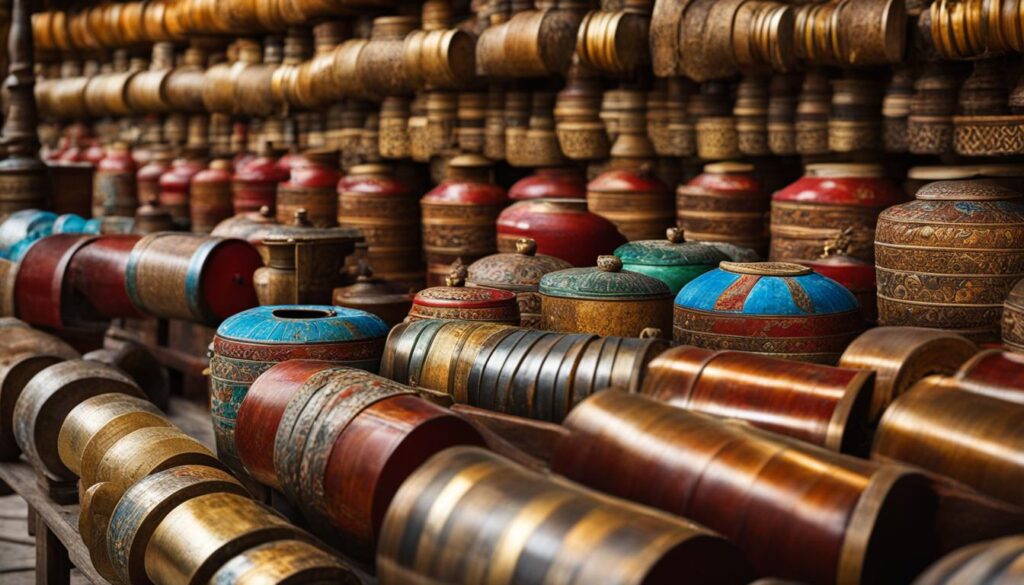
| Material | Characteristics | Symbolism |
|---|---|---|
| Metal | Durable, majestic, and often intricately embellished | Symbolizes strength, sacredness, and protection |
| Wood | Natural, warm, and often carved with intricate designs | Symbolizes grounding, connection with nature, and craftsmanship |
| Stone | Solid, long-lasting, and sometimes decorated with hand-painted motifs | Symbolizes stability, resilience, and the eternal nature of Dharma |
| Leather | Flexible, lightweight, and often embossed with sacred motifs | Symbolizes portability, adaptability, and humility |
| Cotton | Soft, delicate, and often embroidered with mantras or sacred symbols | Symbolizes purity, simplicity, and the interconnectedness of all things |
While these are the most commonly used materials, prayer wheels can also be made from other unconventional materials, including synthetic materials, ceramics, and even recycled materials. These unique and creative prayer wheels offer a contemporary twist to the traditional prayer wheel design, reflecting the diversity of spiritual expression and personal preferences.
Spiritual Function of Prayer Wheels
Prayer wheels serve a significant spiritual function in Tibetan Buddhist practice. By spinning the prayer wheel, practitioners engage their body, speech, and mind in the recitation of mantras, allowing them to accumulate wisdom, merit, and purify negativities. This physical manifestation of prayer and meditation helps deepen mindfulness and cultivate compassion and wisdom in the practitioner.
The benefits of prayer wheel practice extend beyond the individual. It is believed that the spinning of the wheel generates positive energy that brings peace, healing, and protection to the surrounding environment. As the wheel rotates, it is said to radiate blessings, transforming ordinary spaces into sacred ones. The act of spinning the prayer wheel is seen as a powerful act of devotion and connection with the divine, fostering a sense of spiritual connection and enhancing one’s spiritual journey.
Prayer wheel practice offers a profound way to connect with the teachings of Buddhism and internalize its principles. The constant repetition of mantras and the rhythmic spinning of the wheel create a meditative state that helps calm the mind and develop inner peace. The symbolism of the prayer wheel, with its representation of the wheel of Dharma and the noble eightfold path, deepens one’s understanding of the Buddhist teachings and encourages the cultivation of virtues such as compassion, wisdom, and mindfulness.
Benefits of Prayer Wheel Practice:
- Accumulation of wisdom and merit
- Purification of negative karma
- Development of compassion and wisdom
- Protection against negative forces
- Creation of peaceful and sacred spaces
- Fostering a sense of spiritual connection and devotion
- Cultivation of virtues such as compassion, wisdom, and mindfulness
Types of Prayer Wheels
Prayer wheels come in various types and sizes to accommodate different contexts and preferences. Here are some common types of prayer wheels:
- Handheld Prayer Wheels: These are small, portable cylinders with a handle that can be spun by hand. They are often used by individuals during personal meditation practices.
- Large Prayer Wheels: These prayer wheels are fixed and can be found in temples and pilgrimage sites. They are usually larger in size and often have a mechanism to track the number of rotations.
- Row Installations: Row installations consist of multiple prayer wheels arranged in a row. They can be turned by sliding hands over them, offering a unique and interactive experience.
- Water-Powered Prayer Wheels: Some prayer wheels are powered by water, using flowing water to spin the wheel. They are often found in natural settings, such as near rivers or waterfalls.
- Fire-Powered Prayer Wheels: Fire-powered prayer wheels utilize the energy of fire to rotate the wheel. They are less common than other types but can be found in certain Buddhist monasteries or temples.
- Wind-Powered Prayer Wheels: These prayer wheels are designed to be powered by the wind. They harness the natural wind energy to spin the wheel, symbolizing the ever-turning wheel of Dharma.
- Electric Prayer Wheels: In modern times, electric prayer wheels have also emerged. They are powered by electricity and offer a convenient option for continuous spinning without physical effort.
Each type of prayer wheel provides a unique way to engage in the practice of spinning and reciting mantras, allowing practitioners to connect with the spiritual significance and symbolism behind prayer wheels.
| Prayer Wheel Type | Description |
|---|---|
| Handheld Prayer Wheels | Small, portable cylinders with a handle that can be spun by hand. |
| Large Prayer Wheels | Fixed prayer wheels found in temples and pilgrimage sites, often with a mechanism to track rotations. |
| Row Installations | Multiple prayer wheels arranged in a row, turned by sliding hands over them. |
| Water-Powered Prayer Wheels | Prayer wheels powered by flowing water, usually found in natural settings. |
| Fire-Powered Prayer Wheels | Prayer wheels utilizing fire energy to rotate the wheel, often found in monasteries or temples. |
| Wind-Powered Prayer Wheels | Prayer wheels designed to be powered by the wind, symbolizing the ever-turning wheel of Dharma. |
| Electric Prayer Wheels | Prayer wheels powered by electricity, offering a convenient option for continuous spinning. |
These various types of prayer wheels cater to different preferences and contexts, allowing individuals to engage in the practice in a way that resonates with them.
Handheld Prayer Wheels: A Portable Connection with the Divine
Handheld prayer wheels offer a portable way for individuals to connect with the divine. These small cylinders can easily be carried in pockets or bags, allowing practitioners to spin and recite mantras wherever they go. Handheld prayer wheels are particularly popular among individuals who value personal meditation practices or those who wish to have a constant reminder of their spiritual beliefs throughout the day. As the wheel spins, it is believed to emit positive energy and blessings, creating a sense of peace and harmony for the practitioner.
Large Prayer Wheels: Sacred Centers of Devotion
“Large prayer wheels found in temples and pilgrimage sites serve as sacred centers of devotion for many Buddhist practitioners. These prayer wheels are often exquisitely crafted and placed in prominent locations, attracting devotees from near and far. As devotees spin the large wheels with reverence, it is believed that the accumulated merit and prayers benefit not only the individual but also the entire community. The act of spinning a large prayer wheel is considered an act of devotion and a profound gesture of faith.”

Row installations offer a unique and kinesthetic way to connect with the divine. These installations consist of multiple prayer wheels arranged in a row, allowing practitioners to slide their hands over the wheels and spin them simultaneously. This interactive experience creates a tactile connection with the prayer wheels, enhancing the sense of mindfulness and presence during the practice. As practitioners engage in the rhythmic motion of sliding their hands over the row of wheels, it is believed to generate positive energy, purify negativity, and deepen the spiritual connection.
Water-Powered Prayer Wheels: Harnessing the Flow of Life
Water-powered prayer wheels harness the power of flowing water to spin the wheel. These prayer wheels are often placed near natural water sources, such as rivers or waterfalls. As the water flows, it gradually rotates the wheel, symbolizing the ever-flowing cycle of life and the continuous turning of the wheel of Dharma. Water has long been associated with purity and cleansing in many spiritual traditions, and the use of water-powered prayer wheels represents the purification of negative karma and the accumulation of merit.
Unique and Lesser-Known Prayer Tools
In addition to the common cylindrical prayer wheels, there are unique and lesser-known prayer tools used in different Buddhist traditions. These alternative prayer tools offer individuals different ways to engage in prayer and meditation practices, allowing for a more personalized and meaningful experience.
One such lesser-known prayer tool is the handheld prayer wheel in the form of pendants or bracelets. These miniature prayer wheels can be worn as jewelry, serving as a constant reminder for practitioners to engage in prayer and mindfulness throughout the day. They provide a portable and discreet option for those who wish to carry their prayer tool with them at all times.
Another unique prayer tool is the miniature prayer wheel. These small, intricately designed prayer wheels can also be worn as jewelry or kept in personal altars. They serve as a tangible representation of the practice, allowing individuals to connect with their spiritual path in a more tangible way.
Lastly, there are unconventional prayer wheels that incorporate innovative designs or materials. These prayer wheels may deviate from the traditional cylindrical shape and feature artistic interpretations or alternative materials. They offer a creative and contemporary approach to prayer, appealing to individuals who seek a fresh and unique expression of their spirituality.
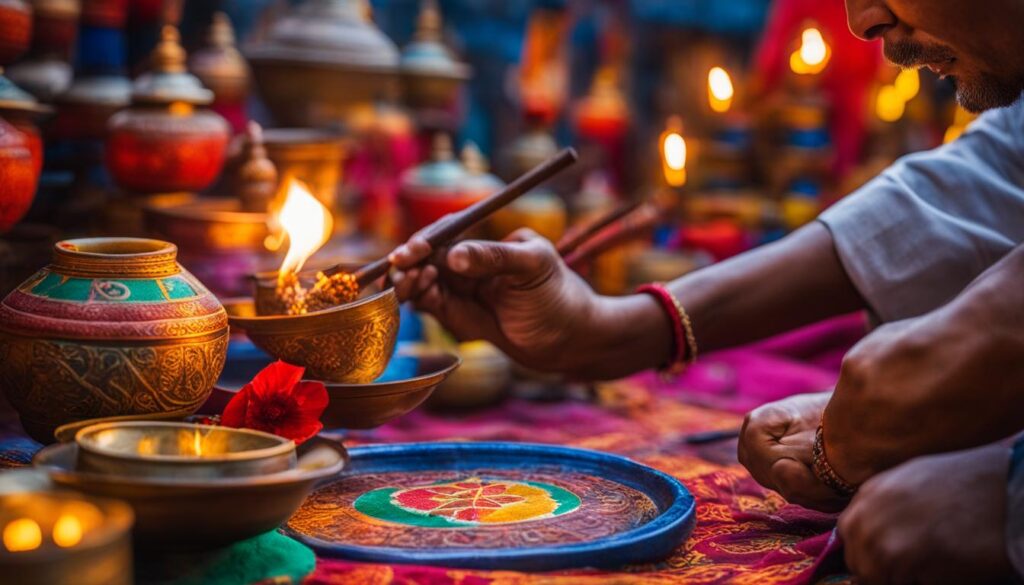
Table: Types of Lesser-Known Prayer Tools
| Prayer Tool | Description |
|---|---|
| Handheld Prayer Wheel Jewelry | Miniature prayer wheels in the form of pendants or bracelets, providing a portable option for practitioners. |
| Miniature Prayer Wheels | Small, intricately designed prayer wheels that can be worn or kept in personal altars. |
| Unconventional Prayer Wheels | Prayer wheels with innovative designs or alternative materials, offering a modern expression of the practice. |
These lesser-known prayer tools provide diverse and creative avenues for individuals to deepen their prayer and meditation practice. Whether they choose to wear a handheld prayer wheel as a constant reminder, utilize a miniature prayer wheel for a more intimate connection, or explore unconventional designs, these alternative prayer tools allow practitioners to personalize their spiritual journey and create a deeper sense of meaning and connection.
Evolution of Prayer Wheel Design: Embracing Modernity
Prayer wheels have undergone significant design changes over time, adapting to advancements in technology and the evolving needs and preferences of practitioners. Modern prayer wheel designs have embraced innovation while maintaining the sacred symbolism and spiritual function of these revered tools.
One notable evolution is the incorporation of lighter materials, such as microfilm, in the construction of prayer wheels. Microfilm prayer wheels have revolutionized the portability of these sacred objects, making it easier for practitioners to carry them during their daily activities. The use of microfilm allows for the inclusion of millions of mantras in a compact format, amplifying the power of prayers.
“Modern prayer wheels have embraced innovation while maintaining the sacred symbolism and spiritual function of these revered tools.”
Another significant design change is the inclusion of bearings and other mechanisms that ensure smoother and easier spinning of the prayer wheel. With the integration of these components, practitioners can engage in the meditative act of spinning the wheel with enhanced ease and grace.
Table: Evolution of Prayer Wheel Design
| Design Element | Description |
|---|---|
| Material | Traditional prayer wheels were heavy and made of metal or wood. Modern designs incorporate lighter materials, such as microfilm. |
| Mechanisms | Modern prayer wheels often feature bearings and other mechanisms to ensure smoother and easier spinning. |
| Size | Traditional prayer wheels varied in size, from handheld to large fixed installations. Modern designs provide a range of sizes to suit individual preferences and contexts. |
Alongside these material and functional changes, prayer wheel designs have become more intricate, showcasing intricate carvings, engravings, and decorative elements. These intricate designs pay homage to the rich cultural heritage surrounding prayer wheels and contribute to their aesthetic appeal.
As prayer wheels continue to evolve, these modern designs ensure that practitioners can engage with these sacred tools in a way that resonates with the contemporary world while honoring the deep-rooted traditions and spiritual significance they hold.
How to Use a Prayer Wheel
Using a prayer wheel is a simple yet profound practice that allows individuals to engage in the recitation of mantras and connect with the spiritual essence of Buddhism. The following guidelines explain the steps to spin a prayer wheel and the rituals associated with this sacred act:
Step 1: Prepare the Mind
- Find a quiet and peaceful space where you can focus your attention.
- Cultivate a calm and clear state of mind by taking a few deep breaths and letting go of any distractions.
Step 2: Hold the Prayer Wheel
- Grasp the prayer wheel firmly with both hands, holding it by the handle or the cylindrical body.
- Position the wheel in front of your heart or at eye level, aligning it with your body’s center.
Step 3: Spin the Wheel
- Start spinning the prayer wheel in a clockwise direction, following the natural movement of the sun in the sky.
- Use a gentle and steady motion, allowing the wheel to rotate smoothly and without interruption.
Step 4: Recite Mantras
- While spinning the prayer wheel, recite the mantra “Om mani padme hum” or any other mantra that resonates with you.
- Let the sound of the mantra reverberate in your mind and fill your being with positive energy and devotion.
By engaging in these simple steps, you can experience the transformative power and spiritual benefits of spinning a prayer wheel. Remember to approach the practice with mindfulness, compassion, and the intention to benefit all beings.
| Step | Instructions |
|---|---|
| Step 1 | Find a quiet and peaceful space. Cultivate a calm and clear state of mind. |
| Step 2 | Hold the prayer wheel firmly. Position it in front of your heart or at eye level. |
| Step 3 | Spin the wheel in a clockwise direction, using a gentle and steady motion. |
| Step 4 | Recite mantras while spinning the wheel. Let the sound resonate in your mind. |
The Symbolic and Spiritual Benefits of Prayer Wheels
Prayer wheel practice offers numerous benefits, both symbolic and spiritual. It is believed to purify negative karma, accumulate merit, develop compassion and wisdom, and protect against negative forces. The spinning of the wheel is a metaphor for the turning of the wheel of the dharma, the teachings of the Buddha. Prayer wheels are considered to have the power to transform individuals, their surroundings, and even entire places into peaceful and sacred spaces. The act of spinning the prayer wheel is seen as a powerful act of devotion and connection with the divine.
One of the main benefits of prayer wheel practice is the purification of negative karma. As practitioners spin the wheel and recite mantras, it is believed that negative actions and thoughts are purified, creating the conditions for positive experiences and outcomes. The accumulation of merit is another significant aspect of prayer wheel practice. Merit is a form of positive energy or good karma that is generated through virtuous actions. Spinning the prayer wheel is considered a meritorious act, contributing to the spiritual progress of both the practitioner and others.
Prayer wheel practice also plays a role in the development of compassion and wisdom. By engaging in the practice with mindfulness and intention, individuals cultivate qualities of kindness, empathy, and understanding. The spinning of the prayer wheel serves as a reminder of the interconnectedness of all beings and the importance of compassionate action. Additionally, the practice of spinning the wheel and reciting mantras enhances concentration and deepens meditative states, leading to the development of wisdom and insight.
Furthermore, prayer wheels are believed to have a protective function. The mantras and prayers inscribed on the wheel are considered powerful and spiritually potent. As the wheel is spun, the blessings and protective energy of the mantras are released, creating a shield against negative influences and harmful forces. The practice of spinning the prayer wheel is seen as a form of spiritual warfare, actively countering negative energies and promoting well-being and positivity.
Conclusion
Prayer wheels hold immense significance in Tibetan Buddhist culture, serving as powerful tools for prayer, meditation, and purification. These cylindrical wheels made from various materials symbolize the wheel of Dharma and carry the essence of the Buddha’s teachings. By spinning a prayer wheel, individuals engage in a practice that accumulates wisdom, merit, and purifies negative karma.
Throughout different Buddhist traditions, prayer wheels come in various forms, sizes, and designs, catering to different contexts and personal preferences. Handheld prayer wheels, large fixed wheels, row installations, and even unconventional designs offer diverse ways to engage in prayer and meditation. These tools are not only used to connect with the divine but also to transform individuals and their surroundings into sacred spaces.
Materials used for prayer wheels have evolved over time, embracing lighter and more intricate designs. While traditional prayer wheels were predominantly made of metal or wood, modern versions incorporate microfilm, bearings, and other innovative materials. These advancements enhance the spinning experience and make prayer wheels more accessible and portable than ever before.
In addition to the common prayer wheels, lesser-known prayer tools such as pendants, bracelets, and miniature prayer wheels offer alternative ways to practice devotion and meditation. Each tool carries the same intention of accumulating wisdom, merit, and purifying negativities, enabling individuals to engage in prayer and meditation practices even in unconventional settings.
FAQ
What are prayer wheels made of?
Prayer wheels can be made from various materials, including metal, wood, stone, leather, or cotton.
What is the significance of spinning a prayer wheel?
Spinning a prayer wheel is believed to have the same meritorious effect as reciting the prayers orally. It is a way to accumulate wisdom, merit, and purify negativities.
How long have prayer wheels been used?
Prayer wheels have been used in Tibet and China since the fourth century. They are believed to have developed from revolving bookcases popular in Buddhist monasteries.
What does the mantra “Om mani padme hum” mean?
The mantra “Om mani padme hum” is associated with the Buddha of compassion, Avalokitesvara, and is believed to contain the essence of the Buddha’s teachings.
Are there variations in prayer wheel practices among different Buddhist sects?
Yes, there may be variations in specific practices and rituals. For example, advanced Tantric practitioners may spin the prayer wheel counterclockwise to manifest a wrathful protective energy.
How do prayer wheels benefit practitioners?
Prayer wheels allow practitioners to accumulate wisdom, merit, and purify negativities. The practice also develops compassion, wisdom, and brings peace, healing, and protection.
What are the different types of prayer wheels?
Prayer wheels come in various types and sizes, including handheld prayer wheels, large fixed prayer wheels, row installations, water-powered prayer wheels, fire-powered prayer wheels, wind-powered prayer wheels, and electric prayer wheels.
Are there any unique prayer tools besides prayer wheels?
Yes, there are unique prayer tools used in different Buddhist traditions, such as hand-held prayer wheels in the form of pendants or bracelets, miniature prayer wheels worn as jewelry, and unconventional prayer wheels with innovative designs.
How should a prayer wheel be spun?
Most practitioners spin the prayer wheel clockwise, following the direction of the sun’s movement across the sky. The spinning should be gentle, and it is recommended to recite the mantra “Om mani padme hum” while turning the wheel.
What are the benefits of using a prayer wheel?
Using a prayer wheel is believed to purify negative karma, accumulate merit, develop compassion and wisdom, and protect against negative forces. It is also seen as a powerful act of devotion and connection with the divine.


